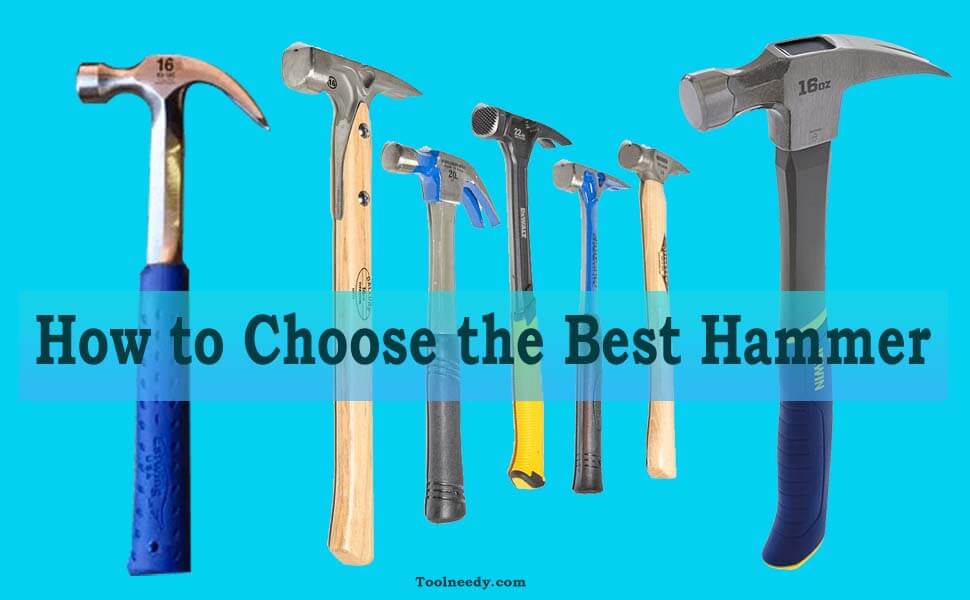Choosing the right tools is not an easy task. You need a lot of knowledge, practical experience, and adequate practice to pick the right tool. A hammer is an amazing gardening tool. There are a lot of fields that hammers are useful. This is why, who we love to do DIY works should know how to choose the best hammer to do our job faster and in a proper way. So, let’s follow a proper guide on how to choose the best hammer. A hammer tool is one of the must-have tools for plumbers.
In this article, we are going to cover ‘how to choose the right hammer’ and ‘everything you need to know about buying a hammer’. So you can tell that you can get all the information about general-purpose hammers. We will cover long hammers for framing carpenters, little precision hammers for woodworkers, brick hammers, and sledgehammers later on. But for now, we will discuss just a regular, all-purpose hammer that would be so important for all DIYers for most of their work.
All tool-users know hammers come with a variety of features, designs, and models. So, picking the best hammer for your work would be the decision for you.
Choosing the best hammer, you must consider 3-design features:
- Medium weight
- Rip claw, and
- Non-wood handle
Contents
Choosing the Best Hammer
What style of hammer do you like best? The classic style or the modern style? Well, we will try to get all those covered here.
Classic Style
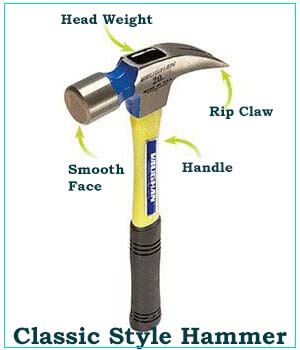
You can see a hammer here. Four of the important parts have been detected and all of them are greatly considerable factors to choose the best hammer. These hammers are time-tested, universal designs, and in a variety of weight and handle designs and materials.
So, let’s discuss those four factors for which would make a hammer the best.
Head Weight
The very first thing which is undeniably the most important factor to consider to be a classic hammer. You may know, classic hammers are obviously defined by the head weight of the hammers. For example, 16 to 20 oz. hammers. They are good for DIY use. A 16 oz. hammer is good for trim and shop use whereas a 20 oz. hammer is always better for framing and demo. So, the head weight of a hammer plays its part well.
Smooth Face
The next indicator for choosing the right and best hammer is its smooth face. Most times a professional or a DIY person use a smooth face hammer. It is chosen because this smooth and wide face hammer works well on any steel or wood material and it doesn’t mar surfaces which is one of the most important matters to consider. However, some framing carpenters choose a “milled face” hammer for some specific reasons. One of them is it doesn’t slip off nail heads as readily.
Handle
The most durable hammer handle is a steel handle and then a fiberglass handle. These handles are commonly used everywhere. For general DIY works and remodeling use, these two kinds of hammer handles are preferred. However, in terms of a wood handle hammer, the grip is usually more slippery and it tends to break easily. Truth be told, the wood handle hammers are good for the shop or trim work. Carpenters barely use this kind of hammer for a general purpose.
In addition, fiberglass handles are lighter while steel handles are more durable. And the wood handles transmit less vibration to the user. People usually don’t consider this little vibration a big deal.
Rip Claw
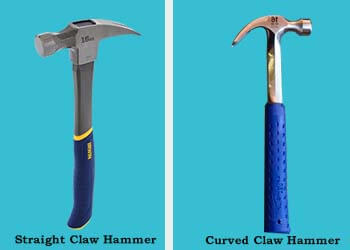
There are two types of rip claws hammers usually seen around us. The straight rip claw and the curved rip claw. In this case, most users prefer straight rip claw hammers for general use. A straight claw is great for framing and demolition tasks because it has more leverage as well as more power for pulling out the bigger nails.
Both types of hammers are useful and helpful. You just need to identify which style you need to complete the job. So, choose the one you need carefully.
Modern Style
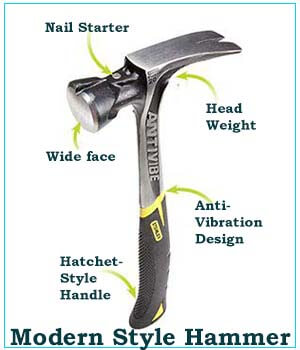
There are common five features that make a hammer modern style. You can easily recognize it once you see it. Those features are really identical. These modern hammers are no big difference from the classic hammers because by changing or tweaking the design of the classical hammers, the modern hammers have been evolved.
However, the modern hammers have new features that are identical.
Nail Starter
This feature is not available to the most modern hammers. A nail starter is typically a groove and magnet that holds a nail. The magnet holds the nail which is high above and you will be risk-free from damaging your fingers or hands. The nail exceeds the head and you can strike the wood or targeted objects and you can successfully do the job without casualty. This process allows freeing one of your hands while working. So, a nail starter is a good feature to mention.
Wide Face
Well, if you are a starter, you may miss some strike. It would not happen frequently if you choose a wide face hammer because it will allow you to cover more area to strike and you won’t miss nails anymore. Once you are an expert you can consider any convenient hammer you want. However, most users or carpenters like to use a wide face hammer.
Hatchet-style Handle
As we know handles of any tools are very important. It needs not only to hold for working, it is a matter of comfort to hold and should not slip from hand if the handle is in a good design. Classical handles are straight with an asymmetrical bulge at the end. However, some modern manufacturers innovated some curved handles and a hooked end—a combination that is more comfortable and non-slippery. It doesn’t even go out of hand for its ergonomic design. Moreover, these types of modern handles are more balanced to control.
Anti-vibration Design
Do you know why some users’ elbows become so sore after long periods of hammering? Yes, the hammer transmits vibrations enough to make the muscle sore. These kinds of hammers are steel-handled hammers. Fiberglass handle and wood handle transmit less vibrations during hammering. Besides, some ergonomically designed handles can dramatically reduce vibration. This is why the anti-vibration design of a hammer is important.
Head Weight
The head weight of a hammer is an important factor to consider. If the head weight is so uneven you cannot control the hammering strike. You cannot balance the hammer too. Some modern-style hammers are similar to classic hammers in terms of their head weights. A lighter yet strong head with a longer handle is able to give high striking force with less overall weight. So, choosing the best hammer focusing on the head weight would be wise too.
What is the Best Hammer for You?
If you are a carpenter or an electrician, you may need some hammers to do your work. A plumber may need a different hammer too. So, a hammer is not just a handle and head, it is more than that.
The hammer which is best for you depends on your nature of works, your strength, capacity, expertness, and so on. Besides, you must have to hold it and feel it which one is comfortable and great for holding and to do the job. The hammer which suits you should be suitable for you.
Just choose the design, style, handle, and weight of it. Feel the hammer and the one that seems better to you would be the best hammer for you. Trust yourself.
Which Hammer Handle Is the Best?
The three most common hammer handles namely steel, fiberglass, and wood are available in the market. Hammer handles come in different lengths. Some hammerheads and handles are either straight, curved, or hatchet style.
Steel Handled Hammers
Hammers handle made of steel are the strongest amongst them. A solid or welded piece of steel is not that easy to beat with a normal hammer. But a steel-handled hammer is able to do that. One discerning matter is the weight but remember, the weight is down away from the strike point, so it doesn’t actually affect the striking power.
One of the drawbacks of a steel-handled hammer is it transmits vibrations enough to make sore elbows or muscles of the users. In addition, heavy vibrations can lead to repetitive strain injuries and other ailments. However, some users claim it is not a big deal.
Fiberglass Handled Hammers
If you want to skip steel-handled hammers, the fiberglass-handled hammer would be one of the options to choose the best hammer. The heads and handles are well built and have great combinations. It is easy to control and doesn’t slip easily. Electricians usually choose fiberglass-handled hammers as they are non-conductive. In addition, plumbers and mechanics like fiberglass because a decent one can be had for not a lot of money.
One mentionable negative factor is that a fiberglass-handled hammer transmits vibration less than a steel-handled hammer but more than a wood-handled hammer. However, considering overall, a fiberglass-handled hammer is the best option for all types of users.
Wood-Handled Hammers
Framers, trim carpenters, and siding installers like a wood-handled hammer very much. As wood handles transmit the least amount of vibration, you can pound on a whole bunch of nails without any problems. Besides, a wood-handled hammer is the most lightweight. In addition, if anyhow damaged the handle, it can easily be replaced and customized with another one.
Though wood-handled hammers are strong but not as strong as steel. Honestly, this type of hammer is not suitable for demo work. Moreover, a hammer made of wood handle tends to break easily.
So, choose the hammer with the handles you like most. Juxtaposing those three, you just decide for yourself the one best for you.
How heavy should a hammerhead be?
Most hammer heads weight is seen between 16 to 22 ounces. It can be misleading because there is no industry standard on how much weight a hammer’s head would be. So, there is no universal standard weight of a hammer’s head. It depends on the manufacturer’s wish and the design they make.
However, there are several things to consider when it comes to the weight of a hammer.
The nature of work – a heavier hammerhead won’t let you do hammering a long period of time. If your work is to hammer all day, a lightweight yet strong hammer should be suitable for you. However, if you are always swinging down low, like a mason building forms, a heavy head hammer is okay then.
The Frequency to use the hammer – if you don’t use a hammer frequently and hang it almost all the time unless it is necessary, a lighter hammer would be okay. The commonsense is there is no point in carrying around a massive weight on your side if you barely ever use it.
Your strength – the strength of a user to handle the hammer is a matter of concern. And depending on the strength of the hammer bearer, the heavy or light hammer should be bought.
Force= Mass x Acceleration.
This means a heavier hammer packs a larger wallop. It only is applicable when you are intending to swing the beast. So a point stands, a hammer becomes too heavy to swing fast, and a greater force would be achieved by swinging a lighter hammer, faster. So, the conclusion for this point is how heavy a hammer should be would depend on the strength of the swinger.
Balance – Balance and control of a hammer are how you love to swing a hammer. Some folks love to swing a hammer with a super heavy head and a light handle while others like the opposite. This is why you must hold and feel the hammer before buying one. You can take help from any experienced ones, neighbors, or friends to buy a perfect hammer.
Which one to pick: Milled faced or Smooth hammerheads
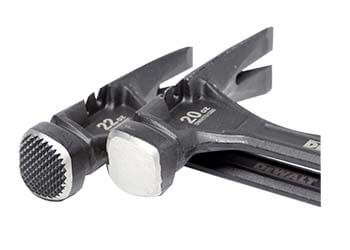
Which one is the best for me – Milled faced or smooth hammerheads? Well, it is a matter of easy solution. Once you know the difference between them, you can make a decision.
A milled-faced hammer, sometimes it is called waffle-head, has a little traction. This hammer is engineered to drive in a nail without bending it over. But remember, the blow of a milled-faced hammer is going to leave a waffle-shaped mark on the surface which is sometimes not expected.
However, the smooth-faced hammer, on the other hand, is good for rough framing or trimming the interior. So, for doing the simple and general work, a smooth head is great. A smooth hammerhead doesn’t put any waffle-shaped marks on materials. So, choose the one you need for your work.
Are titanium hammerheads worth the money?
Hammers made of titanium heads typically cost between $70 and $200. But, truthfully be told, they can sometimes reach up to $300.
So, is the money really worth a titanium hammerhead?
Well, when a hammer made of steelhead strikes a nail, about 30% of the energy from the blow is recoiled back.
But, when it is about titanium hammerhead, only 3% of the energy bounces back.
This means a titanium hammer will get the same results as a much-heavier steel hammer.
Besides, the recoiled energy created from a steel hammerhead doesn’t fully vanish into the ether. Some of them find its way back into the joints of the person in the form of vibrations. However, if you have intentions to work for a longer time like 10 years from now, to keep your organs like wrists, elbows, and shoulders well functioning, a hammer made of titanium is worth the money. You can undoubtedly invest money in it.
In this case, you can choose Stiletto(a 14-OunceTitanium Framing Hammer with Curved Handle).
But one thing you must bear in mind is that if you work with steel, you must have to have a steel hammer because steel is actually harder than titanium.
Hammer claws: straight, or curved?
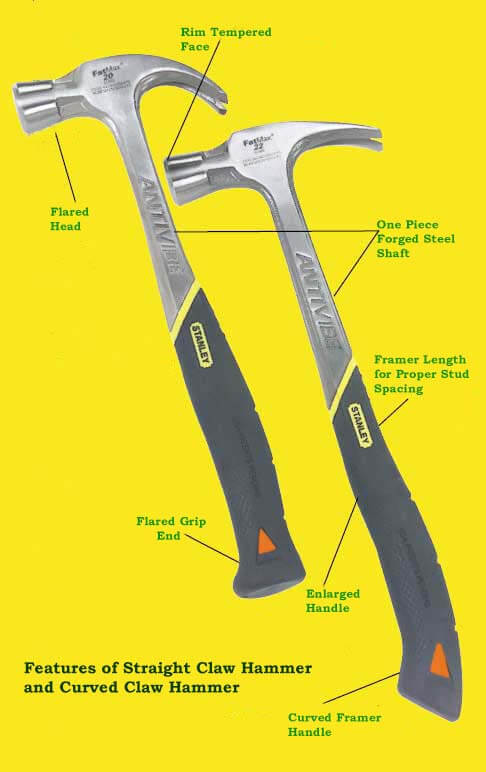
If it is about hammer claws, the question remains which one should I pick – the straight or the curved one?
Straight claws
You should know that a long and straight hammer claw is sharper and is able to stab into a hunk of wood efficiently if you want to grab hold of it. But, straight claws are thinner and have the tendency of breaking off in a severe demo situation. Additionally, short claws are more rugged but they don’t pierce wood as well.
Curved claws
Curved claws are very efficient in pulling out nails from wood without any aid from a spacer. But honestly, it provides less leverage than straight claws. In addition, as curved claws are unable to protrude as far out, they may jab you in the leg when you are trying to crawl around tight spaces.
Whether straight claw hammer or curved claw hammer, both of them have merits and demerits. So, according to your need, you pick the one you need. Most users pick the straight claw hammer because they need to do some demo work with it. So, it totally depends on you which type of hammer you are going to buy or use for your project.
Last Words
If you have read the whole article you may have now already known how to choose the best hammer. Choosing the best hammer also depends on your nature of work, frequency of use, strength, and other criteria. If you want to know about rip claw hammer, best claw hammer, best hammer brand, hammer sizes and weights, and about the most expensive hammer, we will try to write on it later. Stay with us.
Happy Learning!

